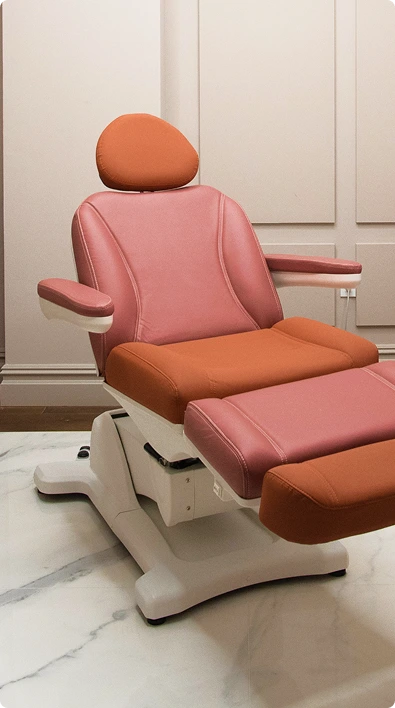GetPlump offers expert chemical peel treatments in NYC, NJ, and Miami, tailored to your skin and cosmetic concerns. Whether you seek a gentle refresh or a deeper rejuvenation, our chemical peels are designed to improve tone, texture, and clarity while fitting seamlessly into your lifestyle. Each location reflects our signature approach: blending advanced skincare with an environment that feels as refined and inviting as the results we deliver.


A chemical peel is a skin treatment that uses a special solution to exfoliate the outer layers of the skin. The chemical solution causes the damaged surface to peel away during the procedure, revealing healthy skin underneath. The treatment typically lasts between 20 and 30 minutes, depending on the type of peel used. This process encourages the skin to renew itself naturally. Over time, the peeling promotes a fresher, smoother appearance by removing dead skin cells.

Superficial peels target just the top layer of the skin using mild acids, such as lactic acid, salicylic acid, and citric acid. These gentle ingredients work to exfoliate the surface without penetrating deeply, making them suitable for light skin refreshment. By removing dead skin cells from the outermost layer, superficial peels help reveal a brighter complexion while promoting gentle skin renewal. This type of peel is often favored for its minimal downtime and subtle results.
Medium-depth peels, also known as medium chemical peels, penetrate beyond the surface to reach the middle layers of the skin. They commonly use ingredients like glycolic acid and trichloroacetic acid to exfoliate more deeply and address issues that require more intensive treatment. These peels stimulate collagen production and cell turnover, resulting in noticeable improvements in skin texture and tone. Medium chemical peels offer a balance between effectiveness and recovery time.
Deep peels are the most intensive form of chemical peels and often involve phenol peels, which penetrate deep into the skin. These deep chemical peels remove damaged skin layers and promote the growth of new skin cells. Because of their strength, deep peels deliver dramatic results but require more extended healing periods. The process encourages significant skin renewal, revealing fresher, rejuvenated skin underneath.

BioRePeel is a modern, two-phase chemical peel designed to exfoliate and revitalize the skin without significant peeling or downtime. Its unique formula combines amino acids, vitamins, and a mild concentration of trichloroacetic acid to stimulate skin renewal and improve overall tone. Unlike traditional peels, BioRePeel works beneath the surface to encourage collagen production while leaving the outer layer largely intact. This makes it a preferred option for patients seeking subtle improvements with minimal disruption to daily life. It is suitable for various skin types and can be used year-round.
The VI Peel is a medium-depth treatment that stands out for its powerful blend of ingredients and versatility across skin tones. It combines trichloroacetic acid, salicylic acid, retinoic acid, and other skin-enhancing components to address various concerns in a single session. The VI Peel is often recommended for individuals who have not responded well to other chemical peels, as it provides comprehensive exfoliation with a manageable recovery time. It penetrates the skin effectively while supporting overall skin health and clarity. This option is commonly used for patients seeking more noticeable improvements in texture, pigment, and tone.
Before a chemical peel is performed, a thorough consultation is conducted to evaluate the patient’s skin type and determine the most suitable peel formulation. This assessment helps identify concerns such as texture irregularities, pigmentation, or fine lines, and ensures the treatment is tailored to the individual’s skin goals. Understanding the skin’s characteristics is essential for choosing the appropriate exfoliating treatment to safely and effectively target the desired skin layer.
On the day of the procedure, the skin is thoroughly cleansed to remove any oils, makeup, or impurities from the skin surface. This step ensures that the chemical solution can be applied evenly and penetrate as intended. In some cases, a degreasing agent is used to strip residual oils, allowing the active ingredients to work more efficiently. The skin is then left to air dry in preparation for the next step.
For superficial peels, no anesthesia is typically required due to the mild nature of the acids used. However, medium and deep peels may require topical numbing cream or local anesthesia, especially when the treatment reaches deeper into the skin layer. This helps minimize discomfort during the procedure, particularly when more potent solutions are involved. The use of anesthesia is determined by the depth of the peel and the patient’s comfort level.
Once the skin is prepped, the selected chemical solution is carefully applied using a brush, gauze, or cotton-tipped applicator. Depending on the peel depth, the formulation may include agents such as glycolic acid, salicylic acid, or trichloroacetic acid. These substances break down the bonds between dead skin cells, facilitating their removal from the outermost skin layer. A tingling or warming sensation is often felt as the exfoliating treatment takes effect.
The solution is left on the skin for a specific amount of time, carefully monitored by our practitioner. During this period, changes in the skin surface, such as frosting or mild blanching, may occur, especially with medium and deep peels. These visible reactions signal that the active ingredients penetrate the appropriate depth. The timing is crucial to prevent overexposure and target the intended skin layer without causing damage.
After the designated time, the chemical solution is either neutralized with a special agent or gently removed, depending on the type of peel. Neutralization halts the chemical reaction and prevents further penetration into the skin. This step marks the end of the active exfoliating process, leaving the skin primed for the regenerative phase. Peeling skin may begin shortly after, particularly with deeper treatments.
A soothing ointment or barrier cream is applied immediately after the procedure to protect the newly exposed skin surface. This helps lock in moisture, reduce irritation, and initiate healing. At this stage, the skin begins its natural renewal process, including the stimulation of collagen and elastin production. As fresh skin emerges, the result is a gradual improvement in texture, tone, and overall skin vitality.

Recovery after a chemical peel varies depending on the depth of the treatment. Superficial peels typically involve minor redness and flaking for a few days, while medium and deep peels may lead to more intense peeling, swelling, and sensitivity lasting up to two weeks or more. Following a recommended skin care regimen is essential to support healing and protect the new skin during this period. Products containing soothing ingredients and antioxidants, including vitamin C, can help strengthen the skin barrier and promote a more even complexion. Sun protection is also critical, as the freshly exfoliated skin is especially vulnerable to UV damage during recovery.
Schedule your consultation to discover how a customized chemical peel can help improve texture, tone, and clarity—revealing a smoother, more luminous complexion. Common side effects include:

Chemical peels are widely used in aesthetic dermatology and must be carefully matched to the right candidates. Before treatment, a thorough evaluation of skin type, medical history, and specific skincare concerns is necessary. While many individuals may qualify, not everyone is an ideal fit.
Here are the typical candidates for chemical peels:
Chemical peels are often chosen as part of a long-term skincare plan to address visible signs of aging, uneven tone, and other common concerns. With various formulations available, they can be tailored to suit different skin types and goals. Over time, consistent treatment can lead to noticeable improvements in overall skin quality.
Chemical peels provide the following benefits:
The cost of chemical peels in NYC, NJ, and Miami ranges from $150 to $600, depending on the depth of the peel and the provider’s experience. Superficial treatments are typically on the lower end, while medium and deep peels cost more due to their intensity and required expertise. Prices may also vary based on the clinic’s location, with higher rates often seen in upscale areas of Manhattan or Miami Beach. Additional costs can include a post-treatment skin care regimen to support healing and enhance results. Some practices also recommend combining chemical peels with vitamin C serums or other targeted skincare products, which may influence the total investment.
Schedule a consultation with our provider for personalized cost estimates.



At GetPlump, chemical peels are more than just cosmetic treatments—they are part of a larger, thoughtfully designed experience that blends luxury service, clinical expertise, and neighborhood-inspired aesthetics. With locations in NYC, Miami, and NJ, we ensure that each space reflects its local character while upholding the same commitment to innovation and comfort. Our approach goes beyond the surface by creating a seamless environment that feels both elevated and welcoming, redefining what an aesthetic medical visit can look like.
Led by a design philosophy that integrates feedback from patients and staff alike, GetPlump has reimagined the standard treatment space to enhance the outcomes and the overall experience. Our distinctive blend of artistry, environment, and advanced skincare expertise sets our chemical peel services apart in the world of modern cosmetic care.
Chemical peels may cause mild tingling, warmth, or stinging during the application, but discomfort is generally minimal and short-lived. Deeper peels may involve more noticeable sensations and require a topical anesthetic or numbing solution. The process involves controlled exfoliation and is designed to stimulate collagen production, which helps renew the skin over time.
Medium and deep peels can improve skin tone, reduce dark marks, and manage more persistent skin conditions such as sun damage or scarring. These treatments penetrate deeper into the dermis and are ideal for patients seeking more intensive correction. They are usually reserved for cases where superficial peels are not sufficient.
Yes, deep chemical peels can help reduce the appearance of deeper wrinkles by targeting the lower layers of the skin and promoting regeneration. While not a substitute for surgical procedures, they can significantly improve cosmetic concerns related to aging and texture irregularities. The results are often more dramatic compared to milder peels.
VI Peel and BioRePeel offer excellent results for many concerns and may provide a more even, toned appearance when used in the right context. Cosmelan, however, is specifically formulated to target pigmentation issues like melasma. Effectiveness depends on the individual’s skin needs and the type of discoloration or texture being addressed.
Menu